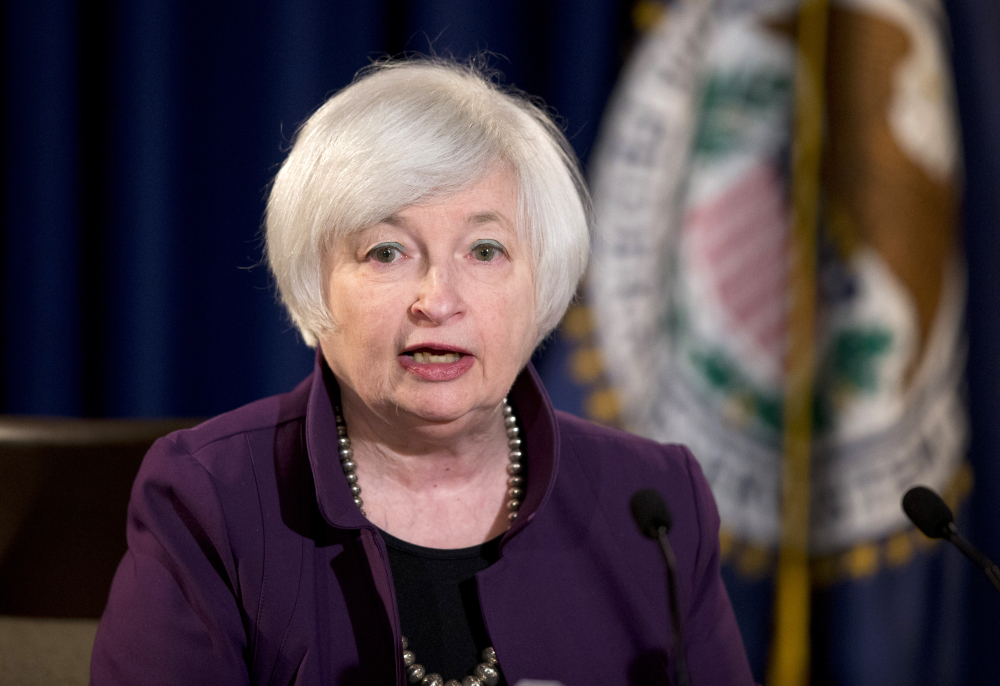WASHINGTON – The U.S. economy has strengthened since a slump early this year, the Federal Reserve said Wednesday, but it wants to see further gains in the job market and higher inflation before raising interest rates from record lows.
While the Fed gave no timetable for a rate hike, all but two of its 17 policymakers think the Fed will raise its key short-term rate sometime this year. That rate has been held near zero since 2008. Many analysts say that if the economy keeps improving, the Fed will likely raise rates in September.
In a statement issued after its latest policy meeting, the Fed said it expects the economy’s gains to accelerate later this year.
The Fed’s decision, which had been widely expected, was approved on a 10-0 vote.
Carl Tannenbaum, chief economist at Northern Trust, noted that policymakers appear sharply divided over how aggressively the Fed will raise rates: Five expect one increase this year, five foresee two increases and five three increases. Two don’t expect any increase this year.
“If you’re an investor trying to get a clear view of what monetary policy might be going forward, there is still a great deal of uncertainty,” said Carl Tannenbaum, chief economist at Northern Trust.
“We are expecting the first move in September,” Tannenbaum said. “But I am not expecting them to move aggressively thereafter. I think they’ll try to be quite cautious … there are still fragile parts of the world economy that might be unsettled by a rapid increase in American interest rates.”
Once the Fed begins raising short-term rates, other rates – for mortgages, auto loans, corporate borrowing – could head higher. Stock and bond prices could be squeezed.
The statement the Fed issued after its latest policy meeting noted that the job market, the housing industry and consumer spending were all improving. The Fed’s assessment contrasts with its previous statement in April, when it noted that the economy weakened during winter.
The Fed said economic activity “has been expanding moderately after having changed little during the first quarter.”
The statement sought to prepare investors for a coming rate hike – if the economy continues to improve – while stressing the reassuring message that it will raise rates very gradually. At the same time, it said that while the job and housing markets had improved, business investment and exports remained “soft.”
Business investment has been hurt by a plunge in energy prices, which have caused cutbacks at energy companies. And U.S. exports have been battered by the rising value of the dollar, which makes American goods more expensive overseas.
In an assessment of the economy, the Fed significantly lowered its estimate of growth this year, from a range of 2.3 percent to 2.7 percent estimated in March to just 1.8 percent to 2 percent. The downgrade reflects the economy’s contraction in the January-March quarter.
The Fed also predicted that the unemployment rate would be 5.2 percent to 5.3 percent by year’s end. Three months ago, it thought unemployment would drop to a range of 5 percent to 5.2 percent by the end of the year. The rate is now 5.5 percent.
The job market has added an average of 217,000 jobs a month this year. The unemployment rate is down from 6.3 percent a year ago and 7.5 percent two years ago.
There are still lingering problems in the labor market. Though average hourly earnings rose 2.3 percent in May from a year ago, wage increases remain generally sluggish. Other labor market indicators – from the number of people jobless for more than six months to the number of part-time workers who would prefer full-time jobs – remain at levels the Fed views as subpar.
Beyond employment, the central bank has yet to achieve its other mandate – promoting stable prices. Inflation has remained persistently below the Fed’s 2 percent annual target. Too-low inflation tends to hold back economic growth.
But in its statement, the Fed seemed to suggest that inflation might soon move back up to its target rate: It said that energy prices, which have fallen sharply in the past year and have held down overall inflation, “appear to have stabilized.”
The Fed wants to take care to avoid spooking investors, who are already on edge over the likelihood of a rate hike and the threat of a default by Greece’s government. The Fed wants to convince the markets that the economy will be sturdy enough to withstand slightly higher rates.
Some economists also note that if a Greek default and an exit from the euro currency alliance were to ignite turmoil in global markets, or if investors dumped bonds and sent long-term rates soaring, the Fed might decide to put off a rate increase until next year.
Whenever the Fed acts, it has made clear that it will raise rates slowly.
“It is almost as though the Fed wants to get the first rate hike out of the way,” Nariman Behravesh, chief economist at IHS, wrote in a research note. “After that, it will take its time and will only gradually tighten monetary conditions further.”
Send questions/comments to the editors.



Success. Please wait for the page to reload. If the page does not reload within 5 seconds, please refresh the page.
Enter your email and password to access comments.
Hi, to comment on stories you must . This profile is in addition to your subscription and website login.
Already have a commenting profile? .
Invalid username/password.
Please check your email to confirm and complete your registration.
Only subscribers are eligible to post comments. Please subscribe or login first for digital access. Here’s why.
Use the form below to reset your password. When you've submitted your account email, we will send an email with a reset code.